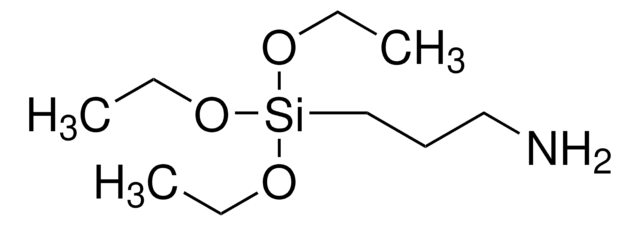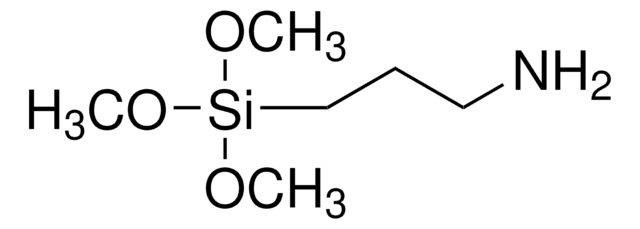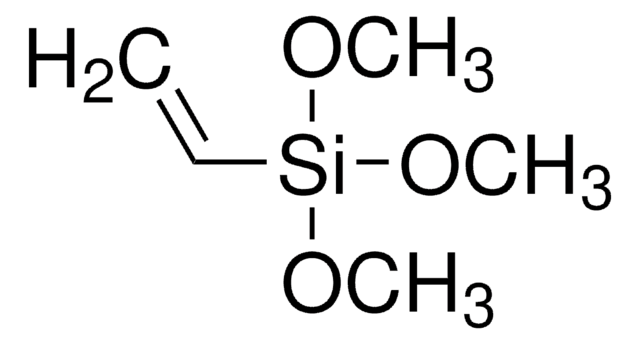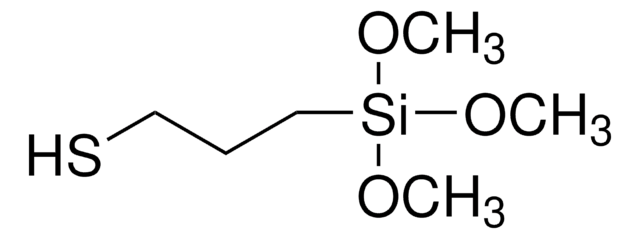Recommended Products
Assay
98%
form
liquid
impurities
1% methyl alcohol from hydrolysis
refractive index
n20/D 1.431 (lit.)
bp
190 °C (lit.)
density
1.045 g/mL at 25 °C (lit.)
SMILES string
CO[Si](CCCOC(=O)C(C)=C)(OC)OC
InChI
1S/C10H20O5Si/c1-9(2)10(11)15-7-6-8-16(12-3,13-4)14-5/h1,6-8H2,2-5H3
InChI key
XDLMVUHYZWKMMD-UHFFFAOYSA-N
Looking for similar products? Visit Product Comparison Guide
Related Categories
General description
Application
TMSPM functionalized Ag-Ce nanocomposites can be used for selective detection of Hg(ll) by the calorimetric method. The significant color change and formation of aggregates of TMPSM functionalized composites in presence of Hg(ll) ions make the probe unique for calorimetric estimation.
TMSPM can be used as a monomer in the synthesis of reactive block copolymers via atom transfer radical polymerization. These block copolymers can be used to construct a variety of hybrid nanomaterials.
Storage Class Code
10 - Combustible liquids
WGK
WGK 1
Flash Point(F)
197.6 °F - closed cup
Flash Point(C)
92 °C - closed cup
Personal Protective Equipment
Certificates of Analysis (COA)
Search for Certificates of Analysis (COA) by entering the products Lot/Batch Number. Lot and Batch Numbers can be found on a product’s label following the words ‘Lot’ or ‘Batch’.
Already Own This Product?
Documents related to the products that you have purchased in the past have been gathered in the Document Library for your convenience.
Difficulty Finding Your Product Or Lot/Batch Number?
How to Find the Product Number
Product numbers are combined with Pack Sizes/Quantity when displayed on the website (example: T1503-25G). Please make sure you enter ONLY the product number in the Product Number field (example: T1503).
Example:
Additional examples:
705578-5MG-PW
PL860-CGA/SHF-1EA
MMYOMAG-74K-13
1000309185
enter as 1.000309185)
Having trouble? Feel free to contact Technical Service for assistance.
How to Find a Lot/Batch Number for COA
Lot and Batch Numbers can be found on a product's label following the words 'Lot' or 'Batch'.
Aldrich Products
For a lot number such as TO09019TO, enter it as 09019TO (without the first two letters 'TO').
For a lot number with a filling-code such as 05427ES-021, enter it as 05427ES (without the filling-code '-021').
For a lot number with a filling-code such as STBB0728K9, enter it as STBB0728 without the filling-code 'K9'.
Not Finding What You Are Looking For?
In some cases, a COA may not be available online. If your search was unable to find the COA you can request one.
Articles
The Progress in Development of Dental Restorative Materials
Professor Aran (Claremont University, USA) thoroughly discusses the engineering of graphene based materials through careful functionalization of graphene oxide, a solution processable form of graphene.
Our team of scientists has experience in all areas of research including Life Science, Material Science, Chemical Synthesis, Chromatography, Analytical and many others.
Contact Technical Service






![3-[Tris(trimethylsiloxy)silyl]propyl methacrylate contains MEHQ + HQ as stabilizer, 98%](/deepweb/assets/sigmaaldrich/product/structures/148/664/33ff5116-f264-4a64-824a-009c2ca5b2b3/640/33ff5116-f264-4a64-824a-009c2ca5b2b3.png)
